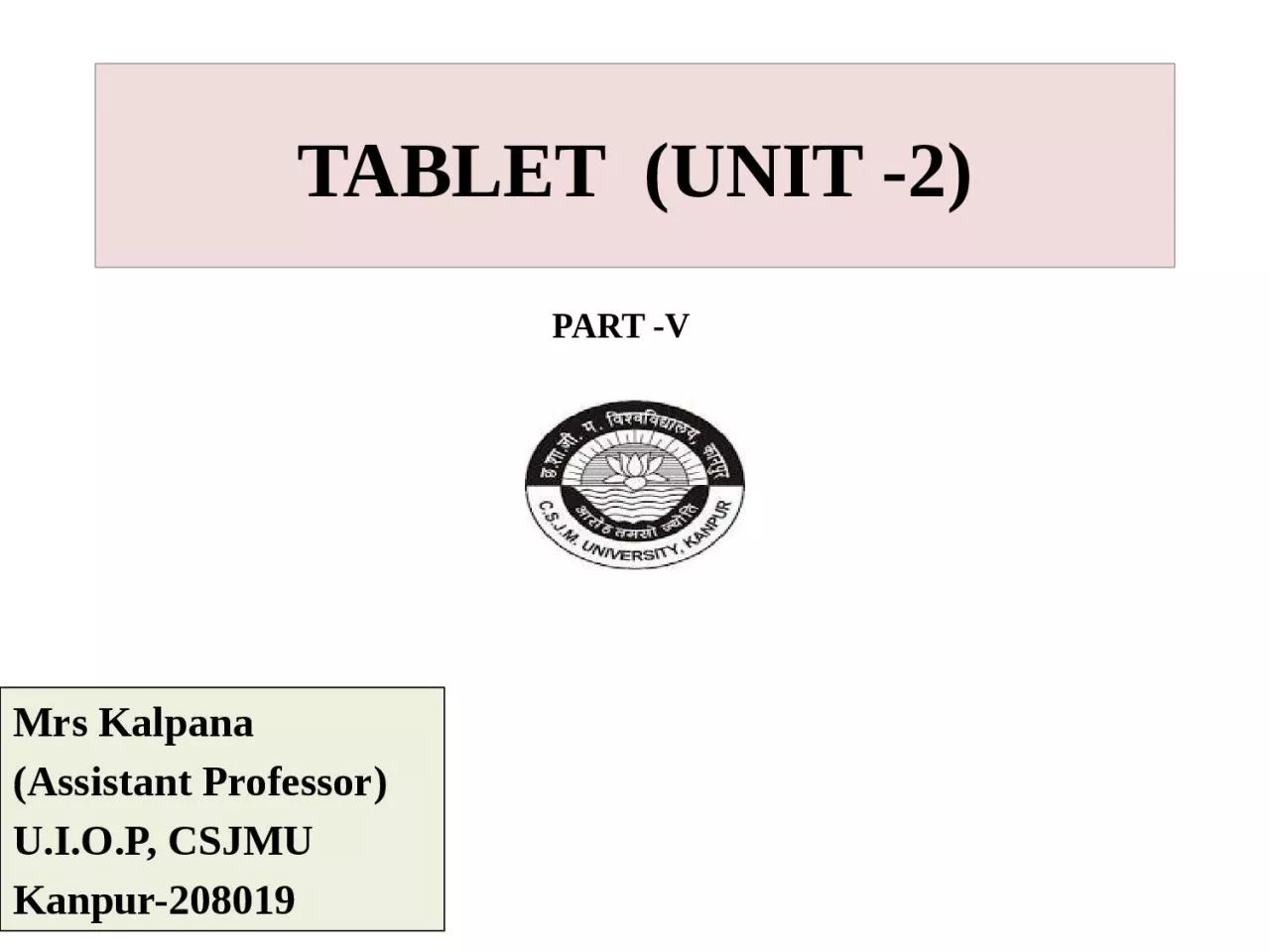

Assistant Professor UIOP CSJMU Kanpur208019 PART V In Process Problems Capping is the partial or complete separation of the top or bottom crowns of a tablet from the main body of the ID: 1020632
Download Presentation The PPT/PDF document "TABLET (UNIT -2) Mrs Kalpana" is the property of its rightful owner. Permission is granted to download and print the materials on this web site for personal, non-commercial use only, and to display it on your personal computer provided you do not modify the materials and that you retain all copyright notices contained in the materials. By downloading content from our website, you accept the terms of this agreement.
1. TABLET (UNIT -2)Mrs Kalpana (Assistant Professor)U.I.O.P, CSJMUKanpur-208019PART -V
2. In Process ProblemsCapping is the partial or complete separation of the top or bottom crowns of a tablet from the main body of the tablet.Capping due to granulation promlemsCauses: Large amount of fines in the granulation Too dry or very low moisture content (leading to loss of proper binding action.Not thoroughly dried granules Insufficient amount of binder or improper binder.Insufficient or improper lubricant. Increase. Granular mass too cold to compress firm.
3. RemediesRemove some or all fines through 100 to 200 mesh screen Add hygroscopic substance e.g.: sorbitol, methyl- cellulose or PEG-4000 Dry the granules properly. Increasing amount of binder OR Adding dry binder such as pre-gelatinized starch, gum acacia, powdered sorbitol, PVP, hydrophilic silica or powdered sugarThe amount of lubricant or change the type of lubricantCompress at room temperature
4. Capping due to Dies, Punches and Tablet PressCausesPoorly finished dies Deep concave punches or beveled-edge faces of punches.Lower punch remains below the face of die during ejection. High turret speed. RemediesPolish dies properly.Use flat punchesMake proper setting of lower punch during ejectionAdjust sweep-off blade correctly to facilitate proper ejectionReduce speed of turret (Increase dwell time).
5. LaminationLamination is separation of a tablet into two or more distinct layers. Both of these problems usually result from air entrapment during processing.Causes Rapid relaxation of the peripheral regions of a tablet, on ejection from a die Causes Rapid decompressionUse pre-compression step. Reduce turret speed and reduce the final compression pressure.
6. MottlingIt is an unequal color distribution on a tablet, with light or dark areas standing on otherwise uniform surface. This results from use of a drug with a color different from that of the tablet excipients or from a drug with colored degradation products.CausesA coloured drug used along with colourless or white-coloured excipientA dye migrates to the surface of granulation while dryingImproper mixing of a coloured binder solution
7. RemediesUse appropriate colourantsChange the solvent systemChange the binderReduce drying temperatureUse a smaller particle sizeIncorporate dry colour additive during powder blending step, then add fine powdered adhesives such as acacia and tragacanth and mix well and finally add granulating liquid
8. Picking and stickingPicking is removal of a tablet’s surface material by a punch. sticking is adhesion of tablet material to a die wall. These two problems result from excessive moisture or substances with low melting temperatures in the formulationCauses:Concavity too deep for granulationToo little pressure. Increase pressureToo little or improper lubrication.. Compressing too fastLow melting point substances, may soften from the heat of compression and lead to pickingToo warm granules when compressing..Too much amount of binder. Reduce the amount of binderEmbossing or engraving letters on punch faces such as B, A, O, R, P, Q, GPressure applied is not enough; too soft tabletGranular material very abrasive and cutting into dies.Granular material too warm, sticks to the die
9. Remedies:Reduce concavity to optimumIncrease pressure.Increase lubrication use colloidal silica as a ‘polishing agent’, so that material does not cling to punch facesReduce speedAdd high melting-point materials. Use high meting point lubricants.Low melting point medicament in high concentration. Refrigerate granules and the entire tablet press.Compress at room temperature. Cool sufficiently before compressionchange the type or use dry bindersPolish faces to high luster.Design lettering as large as possible. Plate the punch faces with chromium to produce a smooth and non-adherent face.Increase pressure to optimum, use wear-resistant dies, reduce temperature.